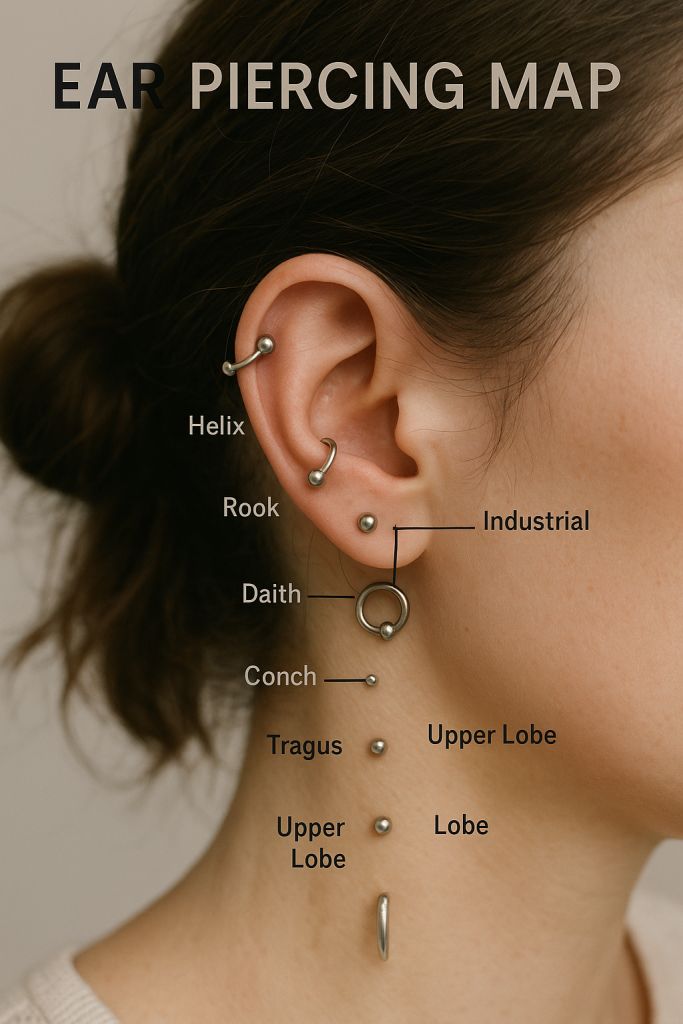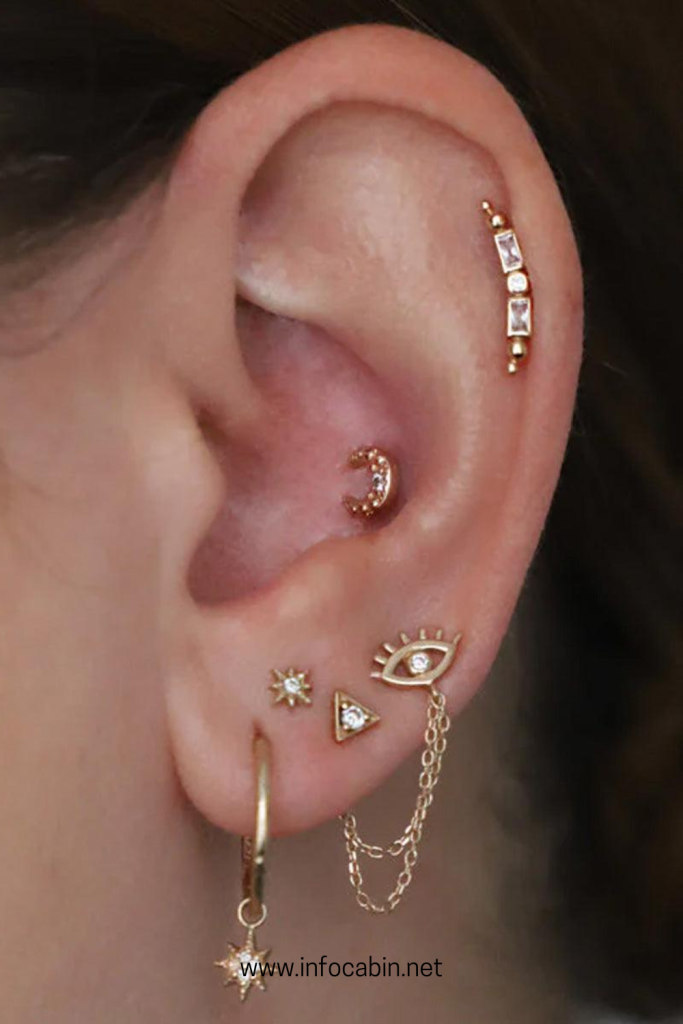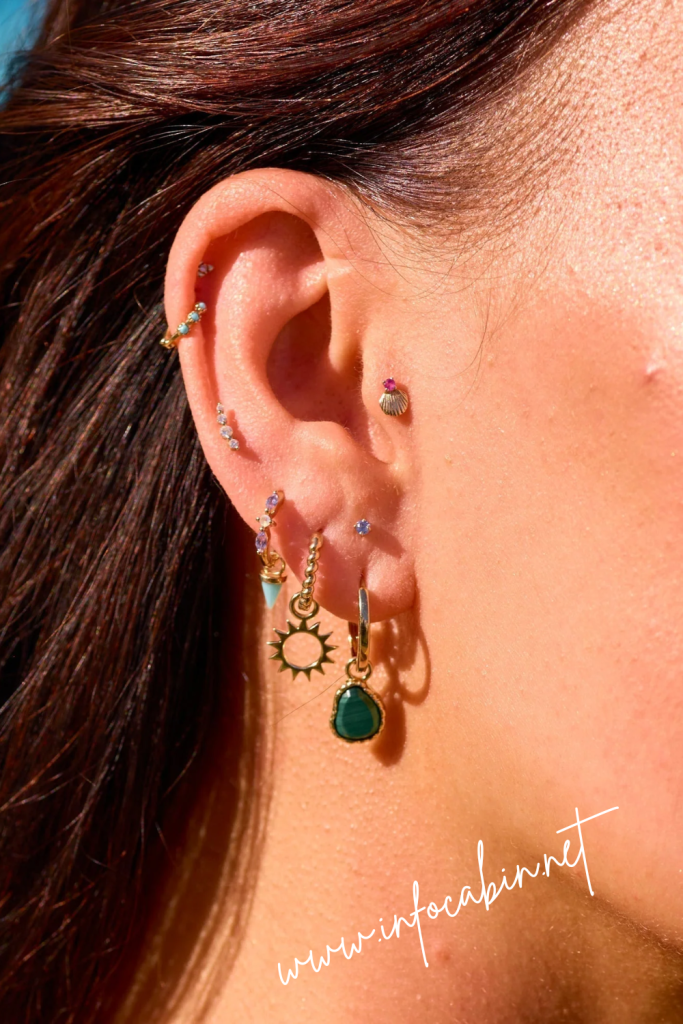Table of Contents
What Exactly Is an Ear Piercing Map?

An ear piercing map is basically a blueprint for your ears—it’s like a layout plan that helps you decide where each piercing should go before you sit in the chair. Instead of guessing or acting on impulse, it gives you a clear vision of what your ear will look like once everything is healed and decorated with jewelry.
Why Planning Beats Random Piercings
Jumping into a piercing without a plan might feel exciting at first, but it often causes regret later—crooked placements, overcrowding, or jewelry that doesn’t sit well. A piercing map helps avoid these issues by keeping things organized.
The Perks of Ear Piercing Mapping
- Keeps your ear looking balanced and intentional
- Lets you plan stages of healing so you’re not overwhelmed
- Matches your overall style—whether sleek, bold, or minimalist
Ear Anatomy Basics
Before designing, you need to know the “landmarks” of your ear.
Lobes (Standard, Upper, and Stacked)
The softest, quickest-healing spot. Classic lobe piercings are versatile; stacked lobes add layers for a chic “ladder” look.
Helix Family (Helix, Forward Helix, Double/Triple)
Runs along the ear’s outer rim. Forward helix piercings face inward toward your face. Multiple helix piercings can create a sleek, linear style.
Inner Cartilage Piercings
- Tragus: That small flap by your ear canal—ideal for tiny hoops or studs.
- Antitragus: Opposite the tragus, more anatomy-dependent.
- Daith: A deep fold above the canal, dramatic when fitted with a hoop.
- Rook: A ridge above the daith, best for curved barbells.
- Snug: Runs along the inner rim, bold but not suited to all ears.
Conch (Inner vs. Outer)
The “bowl” of your ear. Inner conch piercings shine with flat studs or statement clickers; outer conch sits higher, often giving the illusion of floating jewelry.
Industrial/Scaffold
A barbell connecting two points of the helix. High-impact, but more demanding in healing.
Designing Your Ear Piercing Map
Begin With the End in Mind
Picture your dream ear—do you want something subtle and dainty or bold and dramatic? Knowing this first makes planning easier.
Symmetry or Asymmetry?
Balanced on both ears looks clean, while asymmetrical layouts feel more editorial and artsy.
One Ear vs. Both
Focusing on one “feature ear” can save money and healing energy. Doing both builds harmony.
Curated Ear Styles

- Minimalist: Tiny studs, negative space
- Edgy: Industrial bars, black titanium, unique cartilage piercings
- Luxe: Diamonds, gold, and polished clickers
- Boho: Mixed metals, textured hoops, dangling charms
Pain & Healing Expectations
Pain Scale (1–10)
- Lobes: 2–3
- Upper Lobes: 3–4
- Helix/Forward Helix: 4–6
- Tragus: 4–6
- Conch/Daith: 5–7
- Rook: 6–7
- Snug/Industrial: 7–8
Healing Timelines
- Lobes: 6–8 weeks
- Upper Lobe: 8–10 weeks
- Helix/Forward Helix: 3–6 months
- Tragus: 3–6 months
- Conch/Daith: 6–9 months
- Rook/Snug/Industrial: 6–12 months
Healing Helpers & Hurters
Good jewelry, minimal friction, and healthy habits help. Poor metals, pressure, or fiddling with jewelry can slow healing process.
Jewelry 101 for Your Piercing Map
Best Metals
- Implant-grade titanium (ASTM F-136)
- Solid 14k or 18k gold
- Niobium (skin-friendly)
Post Styles
Threadless (push-pin) or internally threaded posts are safe and comfortable. Externally threaded ones? Skip them for fresh piercings.
Jewelry Types
- Labret posts: Flat backs, perfect for cartilage
- Curved barbells: Ideal for rook/daith
- Hoops & clickers: Great for conch, daith, and helix
Gauge Sizes
Typically:
- Lobes: 20g–18g
- Cartilage: 18g–16g
- Industrial: 14g
Choosing the Right Studio
Needles vs. Guns
Needles are clean, precise, and safe. Guns? They damage tissue and can’t be sterilized. Big no.
Hygiene Matters
Look for sealed tools, sterilization equipment, and high-quality jewelry.
Red Flags
Shady studios using unsealed jewelry, vague about materials, or using guns for cartilage piercings.
Aftercare That Works
Saline Over Chemicals
Clean twice daily with sterile saline spray. Skip alcohol, peroxide, or ointments—they delay healing.
Daily Life Adjustments
Sleep with a travel pillow, avoid pressing headphones or helmets, and watch for hair getting caught.
Hands Off!
Resist twisting or poking jewelry. Let it heal without interference.
Handling Piercing Bumps
Irritation Bumps vs. Keloids
Most bumps are irritation, not true keloids. Triggers include pressure, poor jewelry, or tight hoops.
Infection Signs
Severe redness, swelling, pus, heat, or fever. If these appear, see a pro—don’t just remove jewelry.
Tailoring Your Map to Your Ear
Not Every Piercing Fits Every Ear
Some people can’t safely get certain piercings due to cartilage thickness or angles.
Suitability Examples
- Rook needs a defined ridge
- Daith needs a deep fold
- Industrial requires perfect alignment
Workarounds
If your anatomy doesn’t suit one look, there are alternatives—like double helix instead of industrial, or faux rook instead of rook.
Curated Ear Style Examples
Minimal Constellation
Small studs placed with intention across lobe and helix.
Stacked Lobes
Triple or double lobes with descending stone sizes.
Industrial Statement
One long bar plus a conch stud for impact.
Inner-Cartilage Showcase
Daith, rook, and conch creating an inner-ear focal point.
Balanced Power Pair
Different highlights on each ear, like a helix on one side and conch on the other.
Piercings & Lifestyle
At Work
Opt for tiny studs or flat backs that blend in.
Sports & Fitness
Protect with tape or guards. Avoid irritation from helmets or mats.
Travel & Swimming
Skip pools and lakes during healing. On flights, saline spray helps combat dryness.
Budget & Timing
Staging Piercings
Do 1–3 at a time, depending on location. Avoid overloading cartilage at once.
Costs
Piercing fees + jewelry. Quality jewelry costs more, but it lasts.
Downsizing
Usually 2–8 weeks for lobes and 6–12 weeks for cartilage, once swelling reduces.
Sensitive Skin Solutions
Nickel Allergies
Nickel causes rashes and itching. Stick to titanium, solid gold, or niobium.
Hypoallergenic Picks
Avoid plated or cheap metals—they wear down quickly and expose irritants.
Cultural & Personal Meanings
Symbolism
Piercings can carry personal, cultural, or spiritual significance—or just be stylish choices.
Today’s Trends
Modern curated ears favor clean layouts with sparkly but subtle jewelry.
2025 Piercing Trends
Mixed Metals

Silver and gold worn together are in.
Vertical Lobe & Floating Conch
Creative placements that “float” jewelry are on the rise.
Luxury Minimalism
Tiny diamonds making a big statement.
Ethical Jewelry Choices
Sustainability
Lab-grown gems and recycled metals are beautiful and eco-friendly.
Longevity
Invest in timeless, versatile pieces that can be reused across piercings.
Appointment Checklist
Questions to Ask
- What metals do you use?
- How do you sterilize jewelry?
- Do you provide downsizing?
What to Bring
Comfortable clothing, tied-back hair, and patience for aftercare instructions.
Finalizing Your Ear Piercing Map
Plan, Stage, Commit
Sketch your map, schedule stages, and don’t rush.
Adjust Along the Way
Healing and style evolve—your map can too.
Conclusion
Your ear piercing map is more than a trend—it’s a strategy for designing a personal ear layout that’s safe, stylish, and totally you. With the right planning, high-quality jewelry, and mindful aftercare, you’ll create an ear design that lasts a lifetime.
FAQs
1) How many piercings should I get at once?
Most people stick to 1–3 at a time. More can overwhelm your body’s healing process.
2) Can I start with hoops?
Studs are usually best for healing, but some piercers use oversized hoops safely. Always ask first.
3) How soon can I change jewelry?
Lobes: 6–8 weeks if healing well. Cartilage: several months. Check with your piercer before swapping.
4) Are bumps permanent?
No—most irritation bumps disappear with proper jewelry and care. True keloids need medical treatment.
5) What if my ear shape doesn’t allow certain piercings?
Your piercer can suggest alternatives. For example, if an industrial won’t align, a double helix might achieve a similar look.

